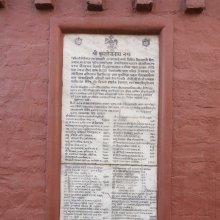Vaksha, Vakṣa, Vakṣā: 8 definitions
Introduction:
Vaksha means something in Hinduism, Sanskrit, the history of ancient India, Marathi, Hindi. If you want to know the exact meaning, history, etymology or English translation of this term then check out the descriptions on this page. Add your comment or reference to a book if you want to contribute to this summary article.
The Sanskrit terms Vakṣa and Vakṣā can be transliterated into English as Vaksa or Vaksha, using the IAST transliteration scheme (?).
Images (photo gallery)
In Hinduism
Ayurveda (science of life)
Source: Wisdom Library: Āyurveda and botanyVakṣa (वक्ष) or Vakṣas is a Sanskrit technical term translating to “chest, breast”, and used in Ayurvedic literature such as the Suśruta-saṃhitā.
Source: gurumukhi.ru: Ayurveda glossary of termsVakṣa (वक्ष):—[vakṣaḥ] Chest

Āyurveda (आयुर्वेद, ayurveda) is a branch of Indian science dealing with medicine, herbalism, taxology, anatomy, surgery, alchemy and related topics. Traditional practice of Āyurveda in ancient India dates back to at least the first millenium BC. Literature is commonly written in Sanskrit using various poetic metres.
Shaktism (Shakta philosophy)
Source: Google Books: ManthanabhairavatantramVakṣā (वक्षा) refers to the “(female) chest”, according to the Kularatnoddyota, one of the earliest Kubjikā Tantras.—Accordingly, “That, O goddess, is said to be the subtle (form), now listen to the gross one. [...] The great conch (she holds) makes her proud and the beauty of her crown enhances her beauty. (She is) adorned with a garland of severed heads that extends from the soles of the feet up to (her) neck. She drips with the blood that flows (from the heads) and is fatigued by the weight of her (dangling) rocking hair. Very fierce, she destroys (the universe) by licking (it up). She has big teeth and a thin stomach. She has long (dangling) breasts and a large chest [i.e., bṛhat-vakṣā]. Her furious form is (lean) without flesh. She has six faces and twelve arms and her back is slightly bent”.

Shakta (शाक्त, śākta) or Shaktism (śāktism) represents a tradition of Hinduism where the Goddess (Devi) is revered and worshipped. Shakta literature includes a range of scriptures, including various Agamas and Tantras, although its roots may be traced back to the Vedas.
India history and geography
Source: Cologne Digital Sanskrit Dictionaries: Indian Epigraphical GlossaryVākṣa.—(Chamba), tax in cash; same as bācha. Note: vākṣa is defined in the “Indian epigraphical glossary” as it can be found on ancient inscriptions commonly written in Sanskrit, Prakrit or Dravidian languages.

The history of India traces the identification of countries, villages, towns and other regions of India, as well as mythology, zoology, royal dynasties, rulers, tribes, local festivities and traditions and regional languages. Ancient India enjoyed religious freedom and encourages the path of Dharma, a concept common to Buddhism, Hinduism, and Jainism.
Languages of India and abroad
Marathi-English dictionary
Source: DDSA: The Molesworth Marathi and English Dictionaryvakṣa (वक्ष).—n S vakṣasthala n S The breast or chest (of female or of male). Ex. karūniyā hāhākāra || vakṣasthaḷa baḍavī nṛpavara ||; also tōṇḍa vakṣasthaḷa piṭīta || ākānta karī adbhuta ||.
Source: DDSA: The Aryabhusan school dictionary, Marathi-Englishvakṣa (वक्ष).—n The breast or chest.
Marathi is an Indo-European language having over 70 million native speakers people in (predominantly) Maharashtra India. Marathi, like many other Indo-Aryan languages, evolved from early forms of Prakrit, which itself is a subset of Sanskrit, one of the most ancient languages of the world.
Hindi dictionary
Source: DDSA: A practical Hindi-English dictionaryVakṣa (वक्ष) [Also spelled vaksh]:—(nm) chest, thorax; ~[sthala] chest, chest region.
...
Kannada-English dictionary
Source: Alar: Kannada-English corpusVakṣa (ವಕ್ಷ):—
1) [noun] the outside part of the thorax; the chest.
2) [noun] either of two milk-secreting glands protruding from the upper, front part of a woman’s body; the breast.
Kannada is a Dravidian language (as opposed to the Indo-European language family) mainly spoken in the southwestern region of India.
See also (Relevant definitions)
Starts with (+12): Vaksara, Vakshah, Vakshahkara, Vakshahkarika, Vakshahsamarddhini, Vakshahsammarddini, Vakshahsammardini, Vakshahstha, Vakshahsthala, Vakshahsvastika, Vakshakchada, Vakshakti, Vakshalaka, Vakshalya, Vaksham, Vakshanestha, Vakshani, Vaksharaka, Vaksharuk, Vakshas.
Ends with (+22): Anvaksha, Ashvaksha, Atyurdhvaksha, Avaksha, Avivaksha, Bilvaksha, Brihadvaksha, Brihatvaksha, Dhvaksha, Gavaksha, Graivaksha, Grivaksha, Gurvaksha, Jalagavaksha, Kaustubhavaksha, Kinnaravivaksha, Kshmavaksha, Lunavaksha, Madhvaksha, Navaksha.
Full-text (+55): Vakshas, Vakshahsthala, Vaccha, Kaustubhavakshas, Vakshoja, Kapatavakshas, Vaksham, Vakshasad, Vakshoruha, Vakshah, Vaksh, Mahavakshas, Nivakshas, Vakshahkara, Pinavakshas, Samtaptavakshas, Vakshasthala, Vankshana, Vakshahstha, Vakshahkarika.
Relevant text
Search found 24 books and stories containing Vaksha, Vakṣa, Vakṣā, Vaksa, Vākṣa; (plurals include: Vakshas, Vakṣas, Vakṣās, Vaksas, Vākṣas). You can also click to the full overview containing English textual excerpts. Below are direct links for the most relevant articles:
Rig Veda (translation and commentary) (by H. H. Wilson)
Sahitya-kaumudi by Baladeva Vidyabhushana (by Gaurapada Dāsa)
Text 10.199 < [Chapter 10 - Ornaments of Meaning]
Text 4.16 < [Chapter 4 - First-rate Poetry]
Text 9.41 [snake diagram] < [Chapter 9 - Ornaments of Sound]
Bhajana-Rahasya (by Srila Bhaktivinoda Thakura Mahasaya)
Text 8 < [Chapter 5 - Pañcama-yāma-sādhana (Aparāhna-kālīya-bhajana–kṛṣṇa-āsakti)]
Bhakti-rasamrta-sindhu (by Śrīla Rūpa Gosvāmī)
Verse 3.4.30 < [Part 4 - Parenthood (vātsalya-rasa)]
Verse 2.4.76 < [Part 4 - Transient Ecstatic Disturbances (vyābhicāri-bhāva)]
Verse 3.5.15 < [Part 5 - Conjugal Love (mādhurya-rasa)]
Chaitanya Bhagavata (by Bhumipati Dāsa)
Verse 3.4.493 < [Chapter 4 - Descriptions of Śrī Acyutānanda’s Pastimes and the Worship of Śrī Mādhavendra]
Verse 1.2.214 < [Chapter 2 - The Lord’s Appearance]
Verse 2.3.130 < [Chapter 3 - The Lord Manifests His Varāha Form in the House of Murāri and Meets with Nityānanda]
